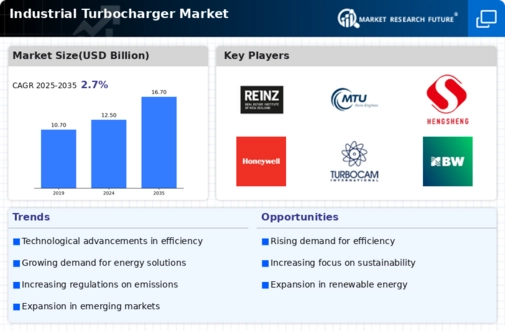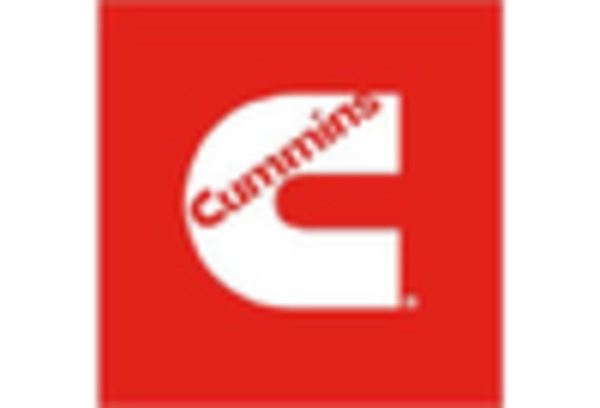Growth in the Automotive Sector
The Industrial Turbocharger Market is poised for growth, particularly due to the expansion of the automotive sector. As consumer preferences shift towards fuel-efficient and high-performance vehicles, manufacturers are increasingly incorporating turbochargers into their engine designs. The automotive industry is projected to witness a significant increase in turbocharged vehicle production, with estimates suggesting that over 30% of new vehicles will feature turbocharged engines by 2026. This trend is driven by the need for improved fuel economy and reduced emissions, aligning with consumer and regulatory demands. The growth of the automotive sector is expected to have a cascading effect on the Industrial Turbocharger Market, as the demand for turbocharging technology continues to rise.
Rising Demand for Energy Efficiency
The Industrial Turbocharger Market is experiencing a notable surge in demand for energy-efficient solutions. Industries are increasingly focusing on reducing operational costs and enhancing productivity, which turbochargers facilitate by improving engine efficiency. According to recent data, turbochargers can enhance fuel efficiency by up to 30%, making them an attractive option for manufacturers. This trend is particularly evident in sectors such as automotive and manufacturing, where energy consumption is a critical concern. As regulations tighten around emissions and energy use, the adoption of turbochargers is likely to accelerate, driving growth in the Industrial Turbocharger Market. Companies are investing in advanced turbocharger technologies to meet these demands, indicating a robust future for this market.
Expansion of Industrial Applications
The Industrial Turbocharger Market is witnessing an expansion in its applications across various sectors. Industries such as power generation, marine, and construction are increasingly integrating turbochargers into their operations to enhance performance and efficiency. For instance, in the power generation sector, turbochargers are utilized to optimize the combustion process, leading to improved energy output. The construction industry is also adopting turbocharged engines in heavy machinery to boost productivity. This diversification of applications is expected to contribute significantly to market growth, as more sectors recognize the benefits of turbocharging technology. The increasing versatility of turbochargers positions the Industrial Turbocharger Market for sustained expansion in the coming years.
Technological Innovations in Turbocharging
Technological advancements are a driving force in the Industrial Turbocharger Market, as manufacturers continuously innovate to enhance performance and efficiency. Recent developments include the introduction of variable geometry turbochargers and electric turbochargers, which offer improved response times and efficiency. These innovations are particularly relevant in the automotive sector, where performance demands are high. The market for turbochargers is projected to grow at a compound annual growth rate of approximately 5.5% over the next few years, driven by these technological enhancements. As industries seek to optimize their operations, the integration of advanced turbocharging technologies is likely to play a pivotal role in shaping the future of the Industrial Turbocharger Market.
Increasing Regulatory Pressure on Emissions
The Industrial Turbocharger Market is significantly influenced by increasing regulatory pressure on emissions. Governments worldwide are implementing stringent regulations aimed at reducing greenhouse gas emissions and improving air quality. Turbochargers play a crucial role in meeting these regulations by enhancing engine efficiency and reducing fuel consumption. For example, the implementation of Euro 6 standards in Europe has prompted manufacturers to adopt turbocharging technology to comply with emissions limits. This regulatory landscape is expected to drive the adoption of turbochargers across various industries, as companies strive to meet compliance requirements while maintaining operational efficiency. The Industrial Turbocharger Market is likely to benefit from this trend as more industries turn to turbocharging solutions to align with environmental standards.


















Leave a Comment